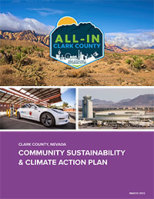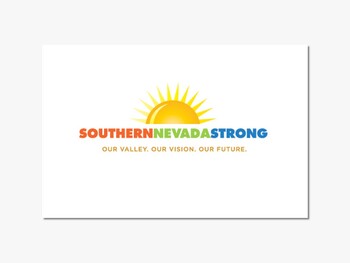 All-In Clark County Resource Center
All-In Clark County Resource Center
 All-In Clark County Resource Center
All-In Clark County Resource Center
This resource center provides access to plans, reports, and fact sheets for initiatives focused on addressing climate change and creating more equitable, sustainable communities in Nevada. Here, you can find materials from the All-In initiative, as well as relevant reports from the county, region, and state.
Clark County's Sustainability and Climate Action Plan: County Operations: Through All-In Clark County, the County aims to promote sustainable practices and climate action within the County’s operations to ensure that it can continue to thrive in the face of climate change. The County Operations Plan focuses on 5 key areas: Clean & Reliable Energy, Resilient County Operations, Smart Waste Management & Reduction, Sustainable Transportation, and Water Conservation & Protection.
Clark County's Sustainability and Climate Action Implementation Plan: Clark County developed an Implementation Plan to accompany the All-In Clark County Sustainability and Climate Action Plan: County Operations. The Implementation Plan is intended to ensure a clear path forward for the many priorities in the County Operations Plan, to identify implementation champions and key partners for specific actions, and to maintain accountability to goals and targets. The Plan contains governance recommendations, an implementation matrix for all actions, and implementation blueprints.
Clark County Climate Vulnerability Assessment (CVA):
The purpose of the Clark County Climate Vulnerability Assessment (CVA), a project of the All-In Clark County initiative, was to assess the current and future potential impacts of climate change in Clark County, Nevada and to develop strategies that reduce those risks to create a more sustainable and resilient future for all. This report summarizes the process and results of the assessment to understand the vulnerabilities of key systems, services, and people to a changing climate.
Clark County 2019 Regional GHG Inventory: Across all sectors, the Southern Nevada Region is responsible for 29,299,795 metric tons of CO2 equivalent in 2019. This is approximately the same amount of emissions as burning a train-load of coal stretching from Las Vegas to Cleveland! Our greenhouse gas emissions come from a variety of sources and we've broken them down to better understand how activities across the communities within Clark County contribute to our region's carbon footprint. Download the inventory report to learn more about what is driving greenhouse gas emissions in Clark County.
Transform Clark County: In 2020, Clark County launched a major effort—Transform Clark County—to establish a cohesive, countywide vision for the future and actionable strategies to achieve that vision. Transform Clark County includes a rewrite of Clark County’s key policy and regulatory documents—the Master Plan and Development Code. The linked site is the community's go-to source for information throughout the process. Navigate to the documents tab to find the full draft master plan and other resources from the planning process. https://www.transformclarkcounty.com/documents
City of Las Vegas 2050 Master Plan: The Las Vegas 2050 Master Plan develops a comprehensive, clear vision and framework for the future of Las Vegas. It follows five guiding principles: equitable, resilient, healthy, livable, and innovative. From its sections about urban forestry to resource conservation, there are connections to sustainability throughout. https://www.lasvegasnevada.gov/Business/Planning-Zoning/Master-Plan/About-Master-Plan
Southern Nevada State of Sustainability Portal: In an effort to build a brighter future for Southern Nevada, ImpactNV compiled the Southern Nevada State of Sustainability data into an interactive data exploration portal. The site evaluates the current status of sustainability in the region and highlights areas in which Southern Nevada excels, as well as potential areas in need of improvement. https://impact-nv.org/interactive/
Recycling and Waste Reduction Report: Since 1991, the Nevada Division of Environmental Protection (NDEP) has tracked the State's recycling efforts and progress towards its 25% recycling goal. This report outlines state recycling legislation, the status of recycling in Nevada, and existing and potential future recycling programs and initiatives.
Strengthening Heat Resiliency in Communities of Color in Southern Nevada: The Guinn Center, in partnership with Morrison Institute at Arizona State University, examined the impact of extreme heat during COVID-19 on Latino and Native American communities in Nevada and Arizona. This report summarizes their findings and includes recommendations for policymakers in Nevada.
Southern Nevada Extreme Heat Vulnerability Analysis: The Southern Nevada Extreme Heat Vulnerability Analysis identifies areas in the region where populations are at high risk to extreme heat. The Regional Transportation Commission (RTC) of Southern Nevada created both a report and an interactive webmap to display the results of the analysis. Both are available on their Extreme Heat Vulnerability page: https://www.rtcsnv.com/projects-initiatives/transportation-planning/planning-studies-reports/extreme-heat-vulnerability/
Nevada Statewide Greenhouse Gas Emissions Inventory and Projections: NDEP's Air Program prepares a greenhouse gas emissions inventory for the State of Nevada, which contains an updated inventory of greenhouse gas emissions, projected greenhouse gas emissions for the 20 years immediately following the date of the report, and a statement of policies to reduce greenhouse gas emissions statewide. The inventory reflects the best and most complete datasets and currently accepted calculation methodologies at the time the report was prepared. This landing page hosts links to the most recent inventory, along with all previous versions. https://ndep.nv.gov/air/air-pollutants/greenhouse-gas-emissions
On Board Mobility Plan: On Board is a mobility plan for Southern Nevada designed to strengthen and diversify the region's transportation network while providing more options to meet the needs of the broader population. It was developed through a combination of technical analysis and input from stakeholders, elected officials, and Southern Nevada residents. Follow the link and scroll down to find the full plan, an executive summary, and other plan resources. https://onboardsnv.com/about-on-board/
Nevada's 2020 State Climate Strategy: The State Climate Strategy is an integrated, economy-wide roadmap for the Silver State to accelerate climate action necessary to achieve Nevada’s climate goals and capture the health and economic benefits of the clean energy and technology transition. The Strategy is just the beginning of future climate action in Nevada. As a living document, the Strategy will be adapted and updated as the impacts of climate change evolve and new climate-friendly technologies become available. https://climateaction.nv.gov/our-strategy/
Southern Nevada Water Authority 2020 Water Resources Plan: The Southern Nevada Water Authority's (SNWA) 2021 Plan provides a comprehensive overview of water resources and demands in Southern Nevada and discusses factors that will influence resource availability and use over a 50-year planning horizon. The Plan introduces the current planning environment, details the SNWA's water resource portfolio, and provides strategies for meeting future water demand and protecting the environment.
Clark County Recycling Report: Each year, the Southern Nevada Health District generates a recycling report to track its progress towards its goal to recycle 25% of all municipal solid waste for all counties with populations over 100,000. Clark County reached this goal for the first time in 2012. Continuing to measure recycling rates provides an opportunity to determine the effectiveness of various recycling programs. Reports are available spanning back to 2006. https://www.watertowndpw.org/169/Auditor
Emergency Operations Plan: This Emergency Operations Plan is an all-hazard plan that describes how Clark County will organize and respond to emergencies and disasters in the community. It consists of a Basic Plan, Emergency Support Function Annexes, and Incident Annexes. As a whole, it describes how the County and its departments will coordinate their resources and activities with other jurisdictions and agencies (federal, state, local) and the private sector (community organizations, faith-based organizations, and others).
Southern Nevada Joint Water Conservation Plan: This Joint Water Conservation Plan addresses the regional water conservation initiatives of a number of wholesale and municipal water agencies in Southern Nevada. It tracks progress towards the Southern Nevada Water Authority's conservation goal of 105 gallons of water per capita per day by 2035 and outlines additional strategies to reach the goal.
California-Nevada Drought Outlook: This short document provides information about current drought status and impacts in California and Nevada, as well as a preview of current and developing climatic events. The document was created as part of a webinar series on drought and climate outlooks hosted by the National Integrated Drought Information System and its partners. For more information about drought in the California-Nevada Region visit Drought.gov.
Sustainability in Action: Created in partnership between the Las Vegas Valley Water District, the Southern Nevada Water Authority, and the Springs Preserve, this sustainability report details the efforts the three groups are making to reduce environmental impacts. It focuses on water, energy, environment, and personal responsibility.
Climate Conditions in Clark County, NV: An Evaluation of Historic and Projected Future Climate using Global Climate Models: The Southern Nevada Water Authority (SNWA) contracted scientists with the California Nevada Applications Program (CNAP) to evaluate and summarize climate data for their service area. This report examines and summarizes historical and projected future climate data specific to Clark County, Nevada. These analyses rely on local weather station information and data from a select suite of global climate models (GCMs) that best represent local, historical climate conditions.
Clark County Multi-Jurisdictional Hazard Mitigation Plan: Clark County has prepared a Multi-jurisdictional Hazard Mitigation Plan (HMP) to assess risks posed by natural and human-caused hazards and to develop mitigation action plans for reducing those risks in Clark County, Nevada. The 2018 HMP replaces the HMP that the County prepared in 2012.
Nevada Infrastructure Report Card: This 2018 Report Card on Nevada’s Infrastructure is the third edition developed by the American Society of Civil Engineers (ASCE) since 2007. This report covers twelve categories – Aviation, Bridges, Dams, Drinking Water, Energy, Public Parks, Roads, Stormwater, Schools, Solid Waste, Transit, and Wastewater. In addition to assigning a grade to each category, ASCE provides recommendations to improve the state's infrastructure. https://infrastructurereportcard.org/state-item/nevada/
UNLV Environment and Sustainability in Nevada: This report offers an overview of key environmental sustainability issues facing Nevada. It identifies steps to improve sustainability and lists community resources available to those interested in helping with the Silver State’s environmental concerns. The report focuses on four key sustainability issues – air, water, land, and energy.
Nevada Solid Waste Management Plan: Nevada's Solid Waste Management Plan provides a description of the existing framework for solid waste management within the applicable laws, regulations, and infrastructure in the state. The Plan describes governmental roles and responsibilities, statewide trends in solid waste management, the assessment of Nevada's municipal solid waste management systems, and solid waste management issues and future considerations. https://ndep.nv.gov/land/waste/solid-waste/solid-waste-management-plan

Access2040: Enhancing Mobility for Southern Nevada Residents: Access2040 is Southern Nevada's Regional Transportation Plan for 2017-2040. It provides a guide for maintaining and improving Southern Nevada's transportation system and identifies the main strategies that local transportation agencies will follow to ensure that Southern Nevadans and the regional economy can thrive as the region continues to grow. https://www.rtcsnv.com/projects-initiatives/transportation-planning/access-2050-regional-transportation-plan/
Southern Nevada Strong Regional Plan: Southern Nevada Strong is a regional plan to establish reliable transportation, quality housing for all income levels, high-quality education systems, strong social services, and high-quality health care. Visit the planning site to view the full plan, an executive summary, and many other resources from the planning process.























